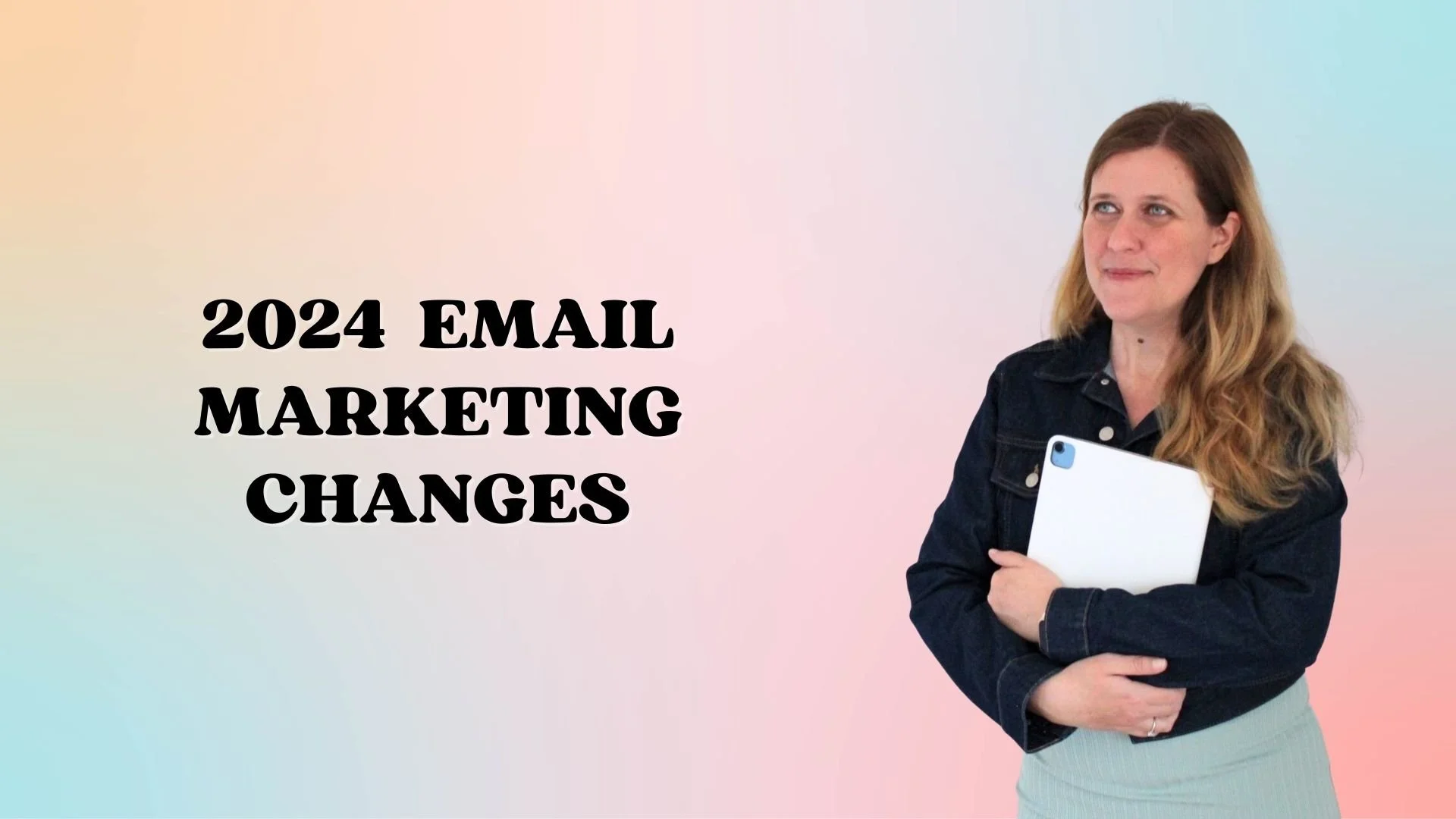2024 Email Marketing Changes
Heads up: this post may contain affiliate links. In other words, if you make a purchase using my link, you won’t pay a dime more but I’ll earn a small commission. My chips and salsa fund thanks you from the bottom of its heart… er stomach?
In today's post, I want to talk about something very important that is going to impact every small business owner who uses email marketing in their business.
If you haven't heard, Google and Yahoo have announced some major changes that are coming to the way that they deliver emails to inboxes that you need to be aware of as a business owner who uses email marketing. So today, I am going to explain what those changes are and what you need to have in place before February 1, 2024 if you want to make sure your emails are still reaching your subscribers.
Google and Yahoo Email Changes - Removing Inactive Accounts
The first change affects inactive Google and Yahoo accounts. Google is one of the most used email providers and Yahoo is the second one. So if you have an email list, chances are the majority of your subscribers use either Google or Yahoo for their email address.
One of the first things that Google announced, and then later Yahoo followed suit, is that they will be deleting or removing inactive accounts, meaning if somebody has a Gmail or a Yahoo email address and they haven't logged into it for the past two years, they will simply be deleting that email.
Now, what this means for your email deliverability is that if you have a lot of subscribers with inactive Gmail or Yahoo accounts, then your email sent to that address will effectively bounce, which will impact your deliverability rate going further.
Google and Yahoo Email Changes - Proper Sender Verification
On top of that both, Google and Yahoo said that they require all bulk senders of emails to be properly verified.
Now, bulk senders of emails, that's us. That's business owners who use email marketing in our business. Technically they did say that these changes will impact only bulk senders that send more than 5000 emails per day, so if you have a smaller list, you might think that this does not apply to you, but I will tell you why you should make those changes or why you should configure everything on the technical side, even if your list is not at 5000 mark yet.
But, what are the changes that you need to have in place? So essentially there are four things you need to pay attention to.
1. Custom Sending Address
First of all, if you're using a free Google or Yahoo email address in your email marketing service providers, such as I don't know, janeblogs@gmail.com, get rid of that immediately and use a custom email address. In other words, you need to have an email address that is associated with your domain name. So if your domain is janeblogs. com, all marketing emails should come from jane@janeblogs.com.
2. SPF, DKIM, and DMARC records
Secondly, you need to have SPF, DKIM and DMARC records in place. What these records do is essentially, without getting too technical and going into too many technical details; they basically tell email providers like Gmail and Yahoo, that your email is legit and it's coming from a legitimate person. It's not spam. It doesn't have any suspicious links, it's not in engaging in any phishing practices or anything like that.
Basically, when you send an email Google will check that email and make sure that it's coming from the person who it claims it's coming from. It'll make sure that your domain checks out. It'll make sure that your IP address that is supposed to send that email checks out on the technical side and all of that stuff, and that is happening behind the scenes.
If you don't have those records in place, then those checks will fail and your email is more likely to end up in spam.
3. One Click Unsubscribe
On top of that, you also need to have one click unsubscribe link in your emails. Now, most email marketing providers provide you with that by default, and you are not supposed to remove it.
You need to have an easy way for your subscribers to opt out of your emails and to unsubscribe. Ideally, this link should be placed at the top of your emails, but in most cases, you will find it that it's located at the footer of your email.
4. Spam Rate Below 0.3%
And finally, the fourth thing that you need to have in place is something that is not entirely within your control, but you can make some changes in your email marketing practice to make sure that you don't go over that threshold. Your spam rate, when you're sending emails, needs to be below 0.3%.
For illustration purposes, if you have a thousand people on your email list, that means it only takes three people to report your email as spam to get to that 0. 3% threshold. Now, this isn't necessarily within your control because you can't control what people do.
And in some cases, if the person who is receiving your email is not very familiar with you, it's really easy for them to just mark your email as spam, simply because it's easier to do that than to hunt down the unsubscribe link. Most people are lazy, unfortunately, and in most email clients, even if they're not using Gmail or Yahoo, but something else like Microsoft Outlook or Apple Mail or Spark or whatever, it's a lot easier to click that link at the top that says unsubscribe and report a spam than it is to scroll all the way down and find the unsubscribe link.
How to Keep Your Spam Rate Below 0.3%
What you can do to keep your spam rate below that threshold is always make it easy for people to unsubscribe. And I would go so far as to say, invite them regularly to unsubscribe.
Unsubscribes are not a bad thing. If somebody unsubscribes from your list, that means they're not the right fit for what you have to offer. So you shouldn't see them as something negative. They're just opening up space on your email list for people who really do want to hear from you.
So I would make it a regular practice to check in with your subscribers every so often, at least once every quarter and invite them to unsubscribe.
Another way to keep your spam rate below 03% is to have a link in the footer of your emails that allows them to unsubscribe from marketing emails but keeps them on your list for updates about purchases they made from you.
Another way that you can make sure that your spam rate stays below the threshold is to have a way for people to opt out of your launch or sales campaigns. That way, they won’t receive additional emails from you but will continue to hear from you once your launch is over.
You can also give them options to choose what they want to hear from you. For example, you can set up your welcome sequence to include an email that includes links to click on on the type of content they want to receive from you.
And then give them a few options. This can include categories that you regularly talk about on the blog, or it could include things like updates and notifications about new products or new courses that you're launching, your services or just free content.
And based on that, you can tailor your email marketing, make it more personalized, and make sure that your subscribers are really getting the content that they want to hear from you. This will not only make sure that your spam rate stays below that threshold, but it'll also help with your overall click rate and open rate.
But What About The 5000 Bulk Sender Limit?
Now let's talk about this 5000 bulk sender email thing that they mentioned. So they said that these rules will mostly apply to people who send 5000 emails per day. And if you have an email list that is, let's say 3000 people, you may be thinking, well, that doesn't apply to me because I only have 3000 people on your list, on my list.
But let's say now you have a launch and usually a launch campaign lasts for about a week. And then you send emails every day and every day you're sending 3000 emails. But then on the last day of your campaign, you might want to send two emails. One in the morning saying it’s the last day to get the special offer and then one about an hour before your cart officially closes. Now you’ve sent 6000 emails in one day and suddenly, those rules apply to you.
And if you don't have the necessary requirements I mentioned above, you risk those emails not being delivered to your subscribers, ending up in spam, and just failing all the checks that they need to pass in order to safely reach your subscribers inboxes.
So even if your list is below 5000 people, I would still say, take some time in your schedule to do this, to set those records up and to make sure that you have a custom domain associated with your email marketing service provider. In most cases you can get a custom domain for $10, $15 from places like Namecheap or GoDaddy. And you can sign up for Google workspace that gives you that professional email address for $6/month.
And then you basically need to set up the SPF, DKIM, and DMARC records. In most cases, your email service provider, such as MailerLite, ConvertKit, Flodesk, will give you a line of code that you need to copy and enter as a text record. In some cases, you will need to create a CNAME record — really depends on your email marketing provider in your domain DNS settings.
The important thing that I want to mention here is that if you have multiple services that are sending emails on your behalf, you may be required to set up an SPF record for all of them.
For example, if you're using something like MailerLite for your email marketing provider, and then you use a service like Bonjoro to send personalized videos, and then you use Dubsado to communicate with your clients and to use your email address. All of those services may require you to set up an SPF record.
The problem with that is if you have multiple SPF records, your domain check will fail and you will end up in spam. You cannot have more than one SPF record per domain. So if you need multiple SPF records, or if you have entered multiple SPF records, they need to be combined into one single record.
As far as DKIM records, you can have multiple of those, that won't cause your domain check to fail.
DMARC is a little more complex, but it's essentially a policy that tells email services such as Gmail or Yahoo, what to do with the emails if they are not coming from an authenticated source. So for example, if your domain is janeblogs.com, and you're sending emails from that domain and you have specified the records to allow ConvertKit and Dubsado to send emails on your behalf, but now somebody somehow got a hold of your email address and they're using it to send emails from somewhere else; a DMARC policy will tell Google to send that email to spam or reject the email or however your specify those rules.
Final Thoughts
So those are the changes that you need to have in place and you need to have them done before February 1st of this year.
Setting this up is not hard. In most cases, it requires you to add a simple line of code to your domain name settings, wherever you're hosting your domain. And it shouldn't take you longer than an hour, not even that to take care of that.
Having said that, if you don't want to mess with it, and if you don't want to take care of it yourself, maybe you're not technologically savvy, maybe you're too busy, whatever, I can help you. All you have to do is click this link and book a time and a date when you’d like me to set this up for you. Once you’re booked in, I’ll be in touch to get the necessary information from you and then log into your email service provider and set up your SPF, DKIM, and DMARC, records for you.
For more tips and tricks, check out these articles:







